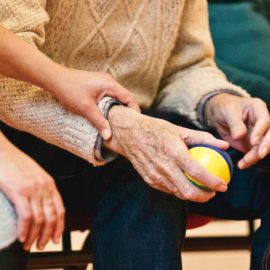

This article is an excerpt from the Shortform book guide to "My Stroke of Insight" by Jill Bolte Taylor. Shortform has the world's best summaries and analyses of books you should be reading.
Like this article? Sign up for a free trial here.
What’s the 90-second rule? How can you use it to manage your emotions effectively?
As neuroscientist Jill Bolte Taylor recovered from a stroke, she received a gift. In the process of regaining her cognitive function and reconstructing her emotional reactions, she learned how to wrangle her emotions by leveraging the 90-second rule.
Read more to learn about Jill Bolte Taylor’s 90-second rule.
The 90-Second Rule
The background of Jill Bolte Taylor’s 90-second rule is in the inspiring story of her recovery. Though recovering from her stroke was a long, arduous, and often painful process, Taylor says she decided to view her stroke and recovery as a gift. Her experience taught her valuable lessons about the inner workings of the mind that she wanted to share with others.
Taylor explains that strong emotions arise in the “animal brain” of your limbic system, which responds to stimuli faster than your right or left brain can process information and floods your brain with chemicals to put you in “freeze, fight, or flight” mode. However, those chemicals are flushed out of your system in approximately 90 seconds, and any emotions you continue to feel are entirely in the realm of your higher brain functions. By this point, you’ve often unconsciously chosen to let your initial reaction continue, feeling it with your right brain and justifying it with your left. While Taylor was rebuilding her reactions from scratch, she realized that, if you’re aware of this process, you can choose to short-circuit it and elect a more balanced response.
(Shortform note: The limbic system serves many more functions than Taylor describes, such as triggering the brain’s reward system, storing and retrieving memories, and managing the body’s autonomic functions. Taylor doesn’t cite any scientific studies to back her claim that the limbic system’s chemicals fade after 90 seconds, nor does she identify which chemicals she means. Adrenaline, for example, can stay in the body for up to an hour. Nevertheless, Taylor’s “90-second rule” has become a touchstone for therapists, who tout it as a powerful technique to promote self-control, deal with stress, and build emotional resilience.)
It helps to become mindful of how emotions manifest themselves in your body. By becoming aware that certain emotions were physically upsetting, Taylor learned that she could avoid those emotions. Doing so led to the realization that how she felt from moment to moment was entirely her own decision. This is where the left brain comes into play, with its constant stream of internal dialogue. Taylor’s inner voice slowly returned as she exercised her language skills, and she learned that she could talk to herself about the way she felt. Instead of letting your own inner voice spin stories that reinforce resentment and anger, Taylor suggests that you can use your self-talk to draw a line between which emotions are helpful and which are destructive.
| Emotional Self-Regulation In How Emotions Are Made, Lisa Feldman Barrett goes a step further than Taylor and suggests that “feelings” and “emotions” are two separate things. Feelings, she says, are your body’s internal signals, such as pleasure or discomfort. Emotions, on the other hand, are mental constructs created by your brain to give your feelings meaning. Like Taylor, Barrett argues that you can consciously manage your emotional responses, both for your sake and the well-being of others around you. Though 21st-century neuroscience has confirmed the brain’s ability to rewire its emotional responses, the idea has been around since at least the fifth century BCE. In Happy, Derren Brown extols the ancient Greek philosophies of the Epicureans and the Stoics, both of whom cited taking responsibility for your emotions as a cornerstone to happiness and life. In The Art of Happiness, the Dalai Lama explains a comparable Buddhist process of cultivating happiness through consciously examining and retraining your thoughts and emotions. |
That’s not to say that you should never feel emotions like anger, sadness, or regret, but only that you should do so consciously so that those emotions don’t control your life. Taylor says it’s particularly useful to give yourself a 90-second break whenever you feel a strong emotional reaction. That allows you time for the limbic system’s chemicals to wash out of your system, after which you can consciously decide on the appropriate emotional response. If it’s necessary to indulge a painful emotion so that it doesn’t go unresolved, Taylor proposes setting aside a specific block of time to feel it, and then telling yourself it’s okay to let it go.
(Shortform note: In Emotional Intelligence, Daniel Goleman gives other practical tips on dealing with feelings such as anger, fear, and grief, but he highlights the importance of being aware of your emotions first. He presents managing your emotions as a preferable alternative to fighting them, which consumes even more energy. He lists the pros and cons of repressing unwanted emotions—some people do it through healthy self-management, while others are simply out of touch with themselves. He does suggest that repressing emotions has been linked to heightened neural activity in the left hemisphere of the brain.)

———End of Preview———
Like what you just read? Read the rest of the world's best book summary and analysis of Jill Bolte Taylor's "My Stroke of Insight" at Shortform.
Here's what you'll find in our full My Stroke of Insight summary:
- A neuroscientist's experience and observations after suffering from a stroke
- How the author's stroke helped her develop empathy and stillness
- How best to support stroke survivors






